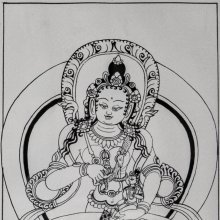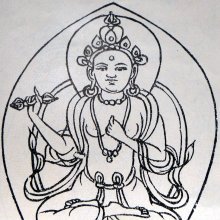Sarvashokatamonirghatamati, Sarvaśokatamonirghātamati: 3 definitions
Introduction:
Sarvashokatamonirghatamati means something in Buddhism, Pali. If you want to know the exact meaning, history, etymology or English translation of this term then check out the descriptions on this page. Add your comment or reference to a book if you want to contribute to this summary article.
The Sanskrit term Sarvaśokatamonirghātamati can be transliterated into English as Sarvasokatamonirghatamati or Sarvashokatamonirghatamati, using the IAST transliteration scheme (?).
Images (photo gallery)
In Buddhism
Tibetan Buddhism (Vajrayana or tantric Buddhism)
Source: Wisdom Library: MañjuśrīnāmasaṃgītiSarvaśokatamonirghātamati (सर्वशोकतमोनिर्घातमति) is one of the sixteen bodhisattvas appearing in the Vajradhātu-mahāmaṇḍala, according to the Nāmamantrārthāvalokinī v5.38-41. The Nāmamantrārthāvalokinī (literally, ‘an explanation of the nāma-mantras’) is a commentary (ṭīkā) on the 8th century Mañjuśrīnāmasaṃgīti.
Sarvaśokatamonirghātamati is a name of Mañjuśrī (the embodiement of non-dual knowledge) and, together with other names, forms the core essence of the Mañjuśrīnāmasaṃgīti. The Nāmamantrārthāvalokinī provides the practitioner a sādhana (‘meditative practice’) to turn these names into mantras. These mantras are chanted for the benefit of all beings, and then placed and contemplated in the Vajradhātu-mahāmaṇḍala, which is an extended version of the Vajradhātu-maṇḍala.
Source: archive.org: The Indian Buddhist IconographySarvaśokatamonirghātamati (सर्वशोकतमोनिर्घातमति) (“destroyer of all sorrows”) is the name of a Bodhisattva commonly depicted in Buddhist Iconography, and mentioned in the 11th-century Niṣpannayogāvalī of Mahāpaṇḍita Abhayākara.—his color is whitish-yellow; his symbol is the staff.—In the Chinese collection, this Bodhisattva is illustrated twice as Tamodghātamati and as Śokanirghātamati .
Sarvaśokatamonirghātamati is described in the Niṣpannayogāvalī as follows:—
Source: Brill: Śaivism and the Tantric Traditions (tantric Buddhism)(1: Mañjuvajra-maṇḍala):—“Sarvaśokatamonirghātamati is of golden complexion. With his two hands joined palm to palm, he displays the attitude of striking”. (2: Dharmadhatūvāgīśvara-maṇḍala):—“Sarvaśokatamonirghātamati is of the red colour of Kuṃkuma (vermillion). With his right hand he holds the Vajra with five thongs and with the left, the Śakti (javelin)”. (3: Durgatipariśodhana-maṇḍala):—“Sarvaśokatamonirghātamati is of mixed white and yellow colour. With his right hand he holds the staff while his clenched left hand rests on the hip”.
Sarvaśokatamonirghātamati (सर्वशोकतमोनिर्घातमति) refers to one of the sixteen Bhadrakalpa Bodhisattvas, according to the Niṣpannayogāvalī 44ff and Abhayākaragupta’s Durgatipariśodhana-maṇḍala (Cf. Niṣpannayogāvalī 66ff.).—A set of sixteen Bodhisattvas often supplements the deities of the Tattvasaṃgraha in later Vajradhātu-maṇḍala descriptions. These are generally the sixteen Bodhisattvas of the present aeon (bhadrakalpa) [e.g., Sarvaśokatamonirghātamati], as described for example in Abhayākaragupta’s Niṣpannayogāvalī Vajradhātu-maṇḍala.—Cf. also Nāmamantrārthāvalokinī and Abhayākaragupta’s forty-three deity Mañjuvajra-maṇḍala (Tricatvāriṃśadātmakamañjuvajra-maṇḍala: see Niṣpannayogāvalī 50)

Tibetan Buddhism includes schools such as Nyingma, Kadampa, Kagyu and Gelug. Their primary canon of literature is divided in two broad categories: The Kangyur, which consists of Buddha’s words, and the Tengyur, which includes commentaries from various sources. Esotericism and tantra techniques (vajrayāna) are collected indepently.
See also (Relevant definitions)
Full-text: Bodhisattva.
Relevant text
Search found 1 books and stories containing Sarvashokatamonirghatamati, Sarvaśokatamonirghātamati, Sarvasokatamonirghatamati; (plurals include: Sarvashokatamonirghatamatis, Sarvaśokatamonirghātamatis, Sarvasokatamonirghatamatis). You can also click to the full overview containing English textual excerpts. Below are direct links for the most relevant articles:
The Indian Buddhist Iconography (by Benoytosh Bhattachacharyya)


